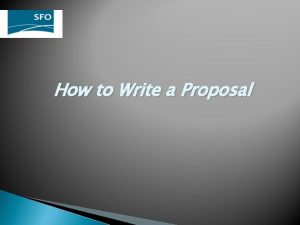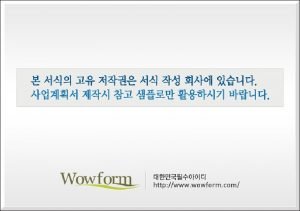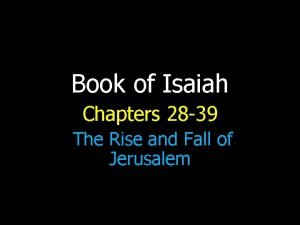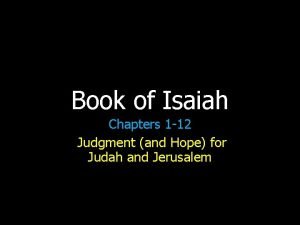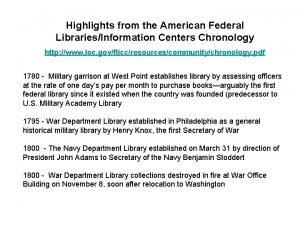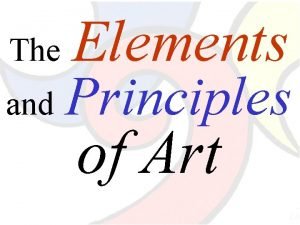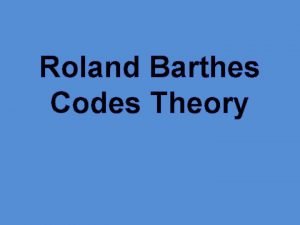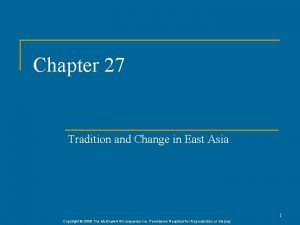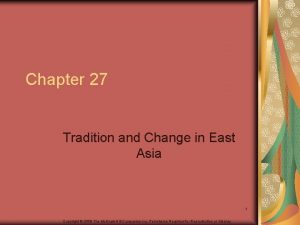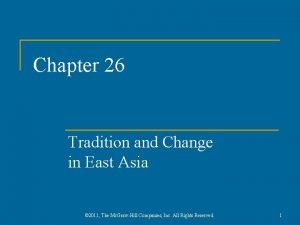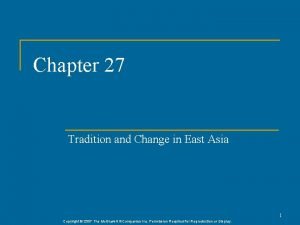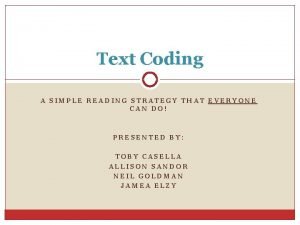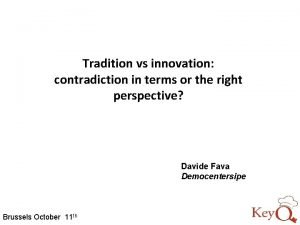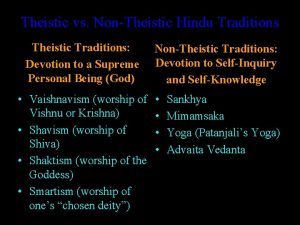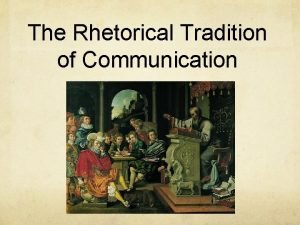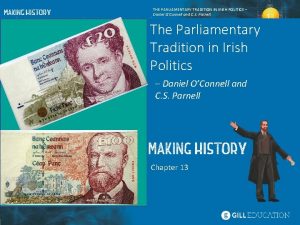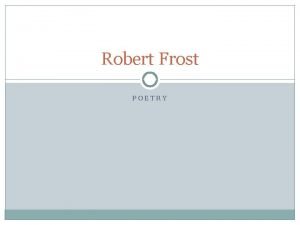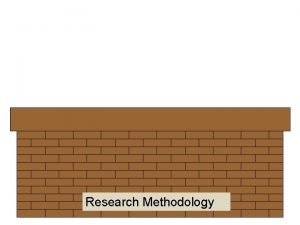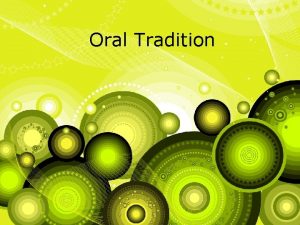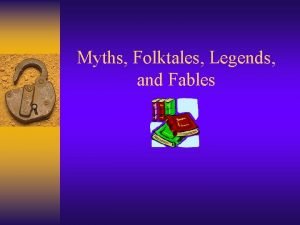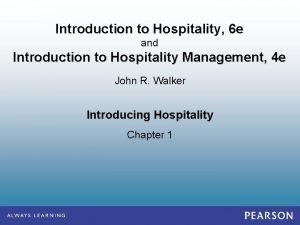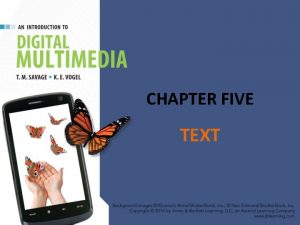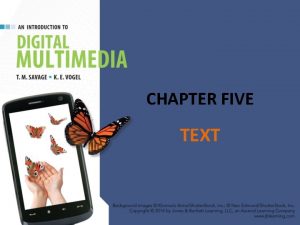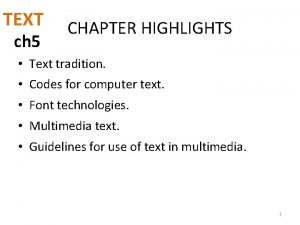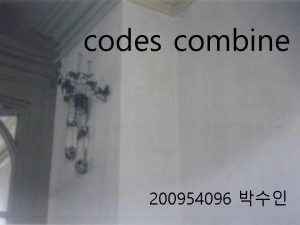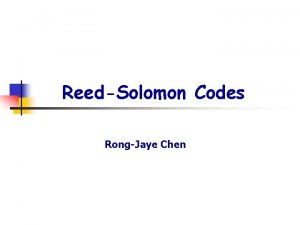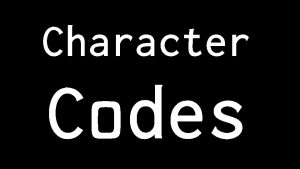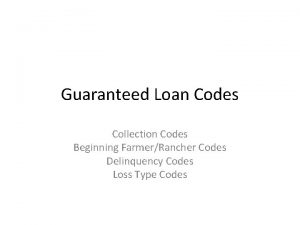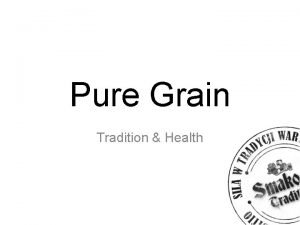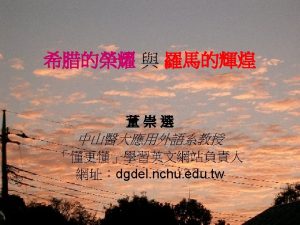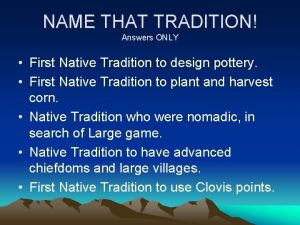CHAPTER FIVE TEXT CHAPTER HIGHLIGHTS Text tradition Codes






























- Slides: 30

CHAPTER FIVE TEXT

CHAPTER HIGHLIGHTS • Text tradition. • Codes for computer text. • Font technologies. • Multimedia text. • Guidelines for use of text in multimedia. 2

POWERS OF TEXT • Multimedia developers value text for: – – Universality Clarity Efficiency Powers of abstraction, engagement, and suggestion. • Developers can explore new uses for text in a media-rich environment. 3

TEXT TRADITION Text properties are grounded in the print tradition. • Typeface is a family of characters sharing a common design. – Arial – Chicago – New York – Palatino 4

TEXT TRADITION Typefaces are commonly categorized as: – – Serif Sans serif Script Symbols. 5

TEXT TRADITION • Style: appearance of characters such as: – Bold – Italic – Underline. • Point size: measure of type size. Point is approximately 1/72 of an inch. Pica is 12 points 6 picas = 1 inch. 6

TEXT TRADITION • Font – Complete set of characters of a particular typeface, style, and size. – Monospaced fonts: same width assigned to each character. – Proportional fonts: adjust width based on shape. • Case – Upper and lower case. Aa 7

TEXT TRADITION • Weight – Line thickness of the typeface. – Arial Black has heavier weight. • Kerning – Adjusting spacing between specific letters. • Tracking – Adjusting spacing between all characters. 8

TEXT TRADITION • Condensed/extended text – Narrow width of text / widen width of text. • Leading – Spacing between lines. • Alignment & Justification – Alignment positions text relative to document's margins. – Justification adjusts line length to produce straight edges on left and right margins. 9

COMPUTER TEXT FROM PRINTED CHARACTERS TO DIGITAL TEXT. 10

COMPUTER TEXT CODES • Coding schemes assign a group of binary numbers to represent a digital character. • ASCII – 7 -bit code = 128 characters. – Extended ASCII or ASCII-8 = 256 characters. • All computers understand ASCII. American Standard Code for Information Interchange 11

COMPUTER TEXT CODES • RTF (Rich Text Format) – Developed by Microsoft for cross platform text files. – Reproduces the formatting of original file. • Unicode – New standard 16 bit code that provides for more than 65, 000 characters. View IT – Goal is to include multilingual text Unicode project. in a digital coding standard. 12

FONT TECHNOLOGIES • Two techniques for displaying text on computer: – Bitmapped fonts – Outline fonts. 13

BITMAPPED FONTS • Pixels that make the letter are described by a binary code, or a "mapping" of the character. – Every character is stored as a bitmapped letter, number, or symbol. – Require large memory and storage capacity. 14

BITMAPPED FONTS • Advantages – Precise control over letter appearance. – Letters can be edited at pixel level. • Disadvantages – Letters can't be easily scaled. – Requires separate bitmaps for each typeface, style, and point size to be used. – Requires large storage capacities. – Limits flexibility in use of text fonts to those stored on the computer. 15

OUTLINE FONTS • Store a description of the character to be displayed. – Description is a series of commands to create the letter on the computer display. • Outline font technology: – Adobe Postscript – True. Type. 16

OUTLINE FONTS • Advantages – Fonts are easily scaled. – Requires smaller storage capacity. • Disadvantages – Commands can't be edited to create unique characters. – Font families are controlled through license of Postscript and True. Type fonts. 17

JAGGIES and TEXT • Text is displayed on a monitor as a pattern of pixels. – Pixels are generally very small squares. – Squares can display straight lines with smooth edges. – Squares that display curved or diagonal lines produce a stair-stepped effect called JAGGIES. 18

ANTI-ALIASING THE JAGGIES • Jaggies produce an alias of the true character. • Anti-aliasing creates a smooth edge by blending the color of the text with the color of the background. 19

INSTALLED FONTS — THE PROBLEM • ASCII and Unicode are standard. • Fonts are not standardized across computer platforms. – If the font is not available on the computer, it will substitute one that is. – The result may not be acceptable. • Solution – Use only widely available fonts. – Package the unique font with the application. 20

MULTIMEDIA TEXT • Two main forms: – Editable: text produced by word processors or text editors. • Easy to alter content. • Can search and spell check. – Graphics: image of text that can be manipulated to produce a wide range of artistic effects. • Make original word picture. • Solves problem of installed fonts. 21

MULTIMEDIA TEXT and SOUND • Speech recognition: software analyzes human speech and converts words to editable text. – Requires specialized "intelligent" software. – Accuracy may depend on training and speaker's voice. • Speech synthesis: software analyzes text and reproduces it as spoken words. 22

TEXT & INTERACTIVITY • Hypertext is linked text. – User interacts with links to trace relationships of words and ideas created by the author. • Structure consists of: – Nodes – Link anchor – Link markers Hyperlink text can take you places. • Hypermedia is an information structure based on linked media. 23

TEXT FOR THE WWW • HTML: hypertext markup language. – Contains "tags" used to specify the structure of the document and format the text and media. – Browser interprets the "tags" and displays the "page" on a client computer. • HTML limitations: – Limited set of tags to create a page. – Difficult to precisely define a page appearance. • Some browsers and client computers may present the html page differently from other browsers. 24

CSS & XHTML • Cascading Style Sheets (CSS). – An addition to HTML – Separates content of page from formatting commands – Easier to edit and maintain consistent appearance of a site. • e. Xtensible HTML (XHTML) – A blending of HTML and XML – XML supports more powerful data manipulation. – XHTML improves page display on mobile devices. 25

PORTABLE DOCUMENT FORMAT • PDF files maintain original formatting of documents across computer platforms. – Platform and application independent. – Support multiple media and user interaction. – Require a reader program to view the file and an application to convert a document to pdf format. • Adobe Acrobat Reader is a free download. • PDFCreator is a free open source converter. 26

ADDING TEXT TO MULTIMEDIA APPLICATION Several methods to incorporate text in an authoring application. – Direct entry in a text box or text field. – Copy and paste from existing text source. – File import for large text files. – Scan text with OCR application for text that exists only in print media. • Optical Character Recognition accuracy will vary based on fonts and quality of source material. 27

GUIDELINES for TEXT in Multimedia Applications • Be selective. • • Be brief. Make text readable. Be consistent. Be careful Be respectful. Combine text with other media. Make text interactive. 28

WRAP UP • • • Traditional text features. Computer text codes. Font technologies. Multimedia text. Adding text to multimedia applications. Guidelines for using text. 29

KEY TERM CHECK UP 30
 Text to text text to self text to world
Text to text text to self text to world Key highlight icon
Key highlight icon Proposal highlights
Proposal highlights Highlights memorandum
Highlights memorandum Investment highlights
Investment highlights Highlights from the book of isaiah
Highlights from the book of isaiah Highlights from the book of isaiah
Highlights from the book of isaiah Objectives in work immersion
Objectives in work immersion The passage highlights……
The passage highlights…… What is principles of arts
What is principles of arts Enigma code theory
Enigma code theory Chapter 27 tradition and change in east asia
Chapter 27 tradition and change in east asia Chapter 27 tradition and change in east asia
Chapter 27 tradition and change in east asia Chapter 26 tradition and change in east asia
Chapter 26 tradition and change in east asia Chapter 27 tradition and change in east asia
Chapter 27 tradition and change in east asia These beauteous forms
These beauteous forms Five of five
Five of five 5 elements and 5 senses
5 elements and 5 senses The devil damn thee black
The devil damn thee black Text codes for reading
Text codes for reading Where tradition meets tomorrow
Where tradition meets tomorrow Tradition vs innovation
Tradition vs innovation Theistic vs non theistic
Theistic vs non theistic Rhetoric tradition of communication
Rhetoric tradition of communication Parliamentary tradition definition
Parliamentary tradition definition Hearsay evidence
Hearsay evidence What aspect of robert frost's poetry breaks from tradition?
What aspect of robert frost's poetry breaks from tradition? Research tradition
Research tradition Oral culture definition
Oral culture definition Stories once passed down orally
Stories once passed down orally The pineapple tradition
The pineapple tradition


